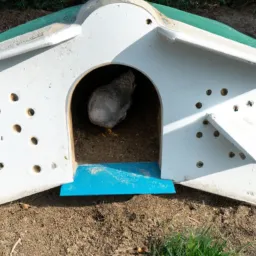Chickens on Wheels: The Ins and Outs of Moving a Mobile Chicken Coop
Mobile chicken coops are becoming increasingly popular among backyard poultry farmers.
They offer numerous benefits over traditional stationary coops, including easier cleaning, improved ventilation, and the ability to move them around your yard for better landscaping management.
In this article, we’ll explore everything you need to know about mobile chicken coops, from how many chickens can fit in one to tips for building and maintaining a portable coop.
Introduction to Mobile Chicken Coops
A mobile chicken coop is essentially a movable structure that houses chickens.
It typically consists of a base or trailer with wheels attached, along with an enclosed area where the birds can roost at night and lay their eggs during the day.
These coops come in all shapes and sizes, ranging from small units designed for just a few hens to larger models capable of accommodating dozens of birds.
How Many Chickens Can You Have in a Mobile Coop?
The number of chickens you can keep in a mobile coop depends on several factors, such as the size of the unit, the breed of chicken, and the amount of space each bird needs.
As a general rule, it’s recommended to allow 2-3 square feet per bird inside the coop, plus additional outdoor space for exercise and scratching.
For example, if you have a mobile coop measuring 8 x 10 feet (or 80 square feet), you could comfortably house up to 16 chickens.
However, this may vary depending on other factors like climate, seasonality, and individual preferences.
Benefits of Moving Your Chicken Coop
One of the biggest advantages of using a mobile chicken coop is that it allows you to easily relocate your flock throughout your property.
See also The Truth Behind Fake Chicken Coop Eggs
This can be especially useful when managing parasites or disease, as moving the coop regularly helps prevent buildup and spread.

Also, by rotating the location of your coop, you can reduce soil compaction and improve grass growth, which ultimately leads to healthier pastures for your chickens.
Tips for Building and Maintaining a Portable Chicken Coop
Building a mobile chicken coop requires careful planning and attention to detail.
Here are some tips to help ensure success:
1. Choose the right materials – When selecting materials for your coop, opt for durable and weatherproof options like wood, metal, or plastic. Make sure they’re also easy to clean and disinfect.
2. Consider accessibility – Ensure your coop has easy access points for feeding, watering, and collecting eggs. This will make daily maintenance much simpler.
3. Provide adequate ventilation – Poor air quality can lead to respiratory problems for your chickens, so make sure there are plenty of vents and windows to promote good circulation.
4. Keep predators at bay – Protect your flock from potential threats by installing secure locks and latches, covering any gaps or openings, and positioning the coop away from trees or shrubs.
5. Regularly clean and sanitize – Cleaning your coop regularly not only keeps it fresh but also reduces the risk of diseases and parasite infestations. Use a mixture of bleach and water to disinfect surfaces, then rinse thoroughly before refilling food and water sources.
Investing in a mobile chicken coop offers numerous benefits, including improved landscaping management, reduced soil compaction, and easier cleaning and maintenance.
See also Nutrena Chicken Feed: The Secret to Happy and Healthy Hens
By following these tips for building and maintaining a portable coop, you can create a safe and comfortable environment for your feathered friends while enjoying fresh eggs year-round!
